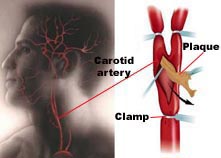

 |  |

![]() Stroke is the third leading cause of
death in this country.
The major cause of stroke is disease in the carotid arteries, which supply blood to the brain. Stroke from hardening of the arteries (atherosclerosis; see below) may be prevented by surgical
intervention (carotid endarterectomy). At Stony Brook, our goal is to reduce the number of strokes in our patients.
Stroke is the third leading cause of
death in this country.
The major cause of stroke is disease in the carotid arteries, which supply blood to the brain. Stroke from hardening of the arteries (atherosclerosis; see below) may be prevented by surgical
intervention (carotid endarterectomy). At Stony Brook, our goal is to reduce the number of strokes in our patients.
The term stroke actually refers to a large range of diseases, the usual result of which is the sudden onset of symptoms; from mild weakness of an arm or leg to loss of speech, paralysis, coma, and death. Many people with this disease have no symptoms. A serious problem, TIAs (transient ischemic attacks, often called "mini-strokes") are strokes, but the symptoms last less than 24 hours.
A TIA is a big warning that a major stroke is in your future. This is not something to take lightly. Although these events are often called "mini-strokes" and shrugged off by patients and even some doctors, they should not be ignored. For 1 in 3 people, a TIA will result in a full-blown stroke within five years, if left untreated. Usually the strokes occur within a few days or a weeks of the TIA. The buildup of plaques in the carotid or vertebral arteries happens over time, and there are usually no symptoms until the narrowing reaches a critical state.
 For an excellent online resource on stroke, see the American Heart Association's Heart and Stroke Encyclopedia.
For an excellent online resource on stroke, see the American Heart Association's Heart and Stroke Encyclopedia.
Varicose veins are blood vessels, usually in the legs, that become permanently dilated (widened) and twisted. They may include superficial veins, deep veins and veins that connect superficial and deep veins. The signs of varicose veins are enlarged, disfiguring, snakelike, bluish veins which are visible under the skin upon standing; they appear most often in the back of the calf or on the inside of the leg from ankle to groin. Symptoms may include vague discomfort and aching in the legs, especially after standing; and fatigue. Click here to see photos of varicose veins in the leg before and after treatment.
Spider veins—for which the medical term is telangiectasias—are tiny, superficial blood vessels which have become permanently dilated. The veins are generally blue, red, or purple in color. Although spider veins can occur on most areas of the body, common sites for the condition are the legs and face. Up to 41% of women and 15% of men in the United States have spider veins. The veins usually cause no serious problems, but some patients experience burning or pain in the affected area of the body. For many people, especially those with large areas of spider veins, the condition can be cosmetically unappealing. Click here to see photos of spider veins in the leg before and after treatment.